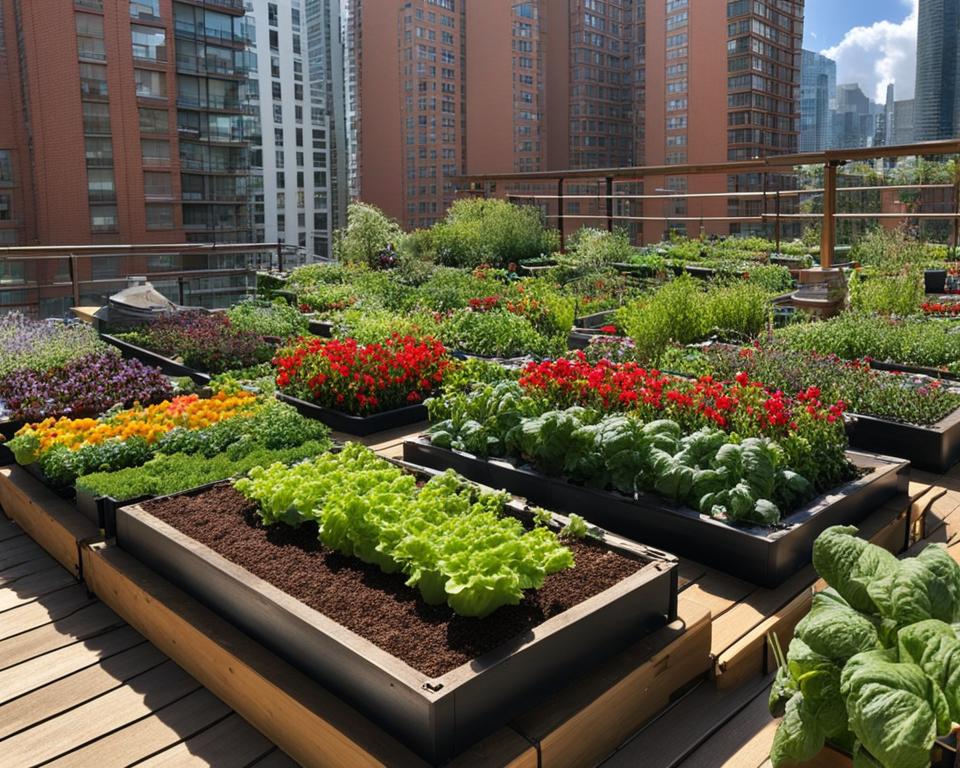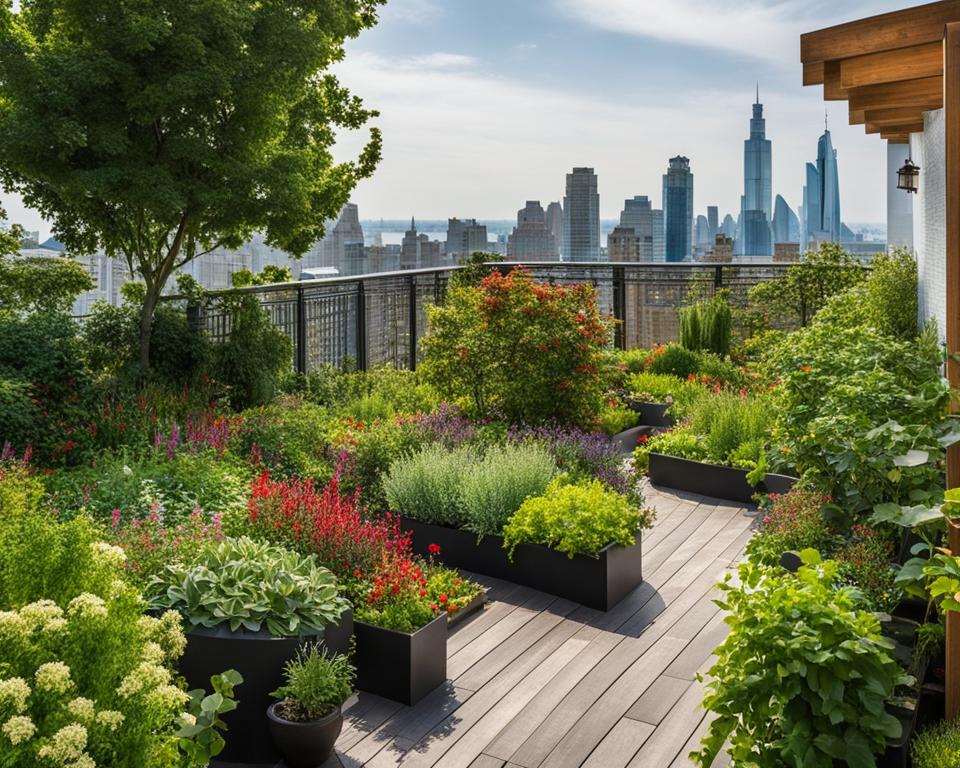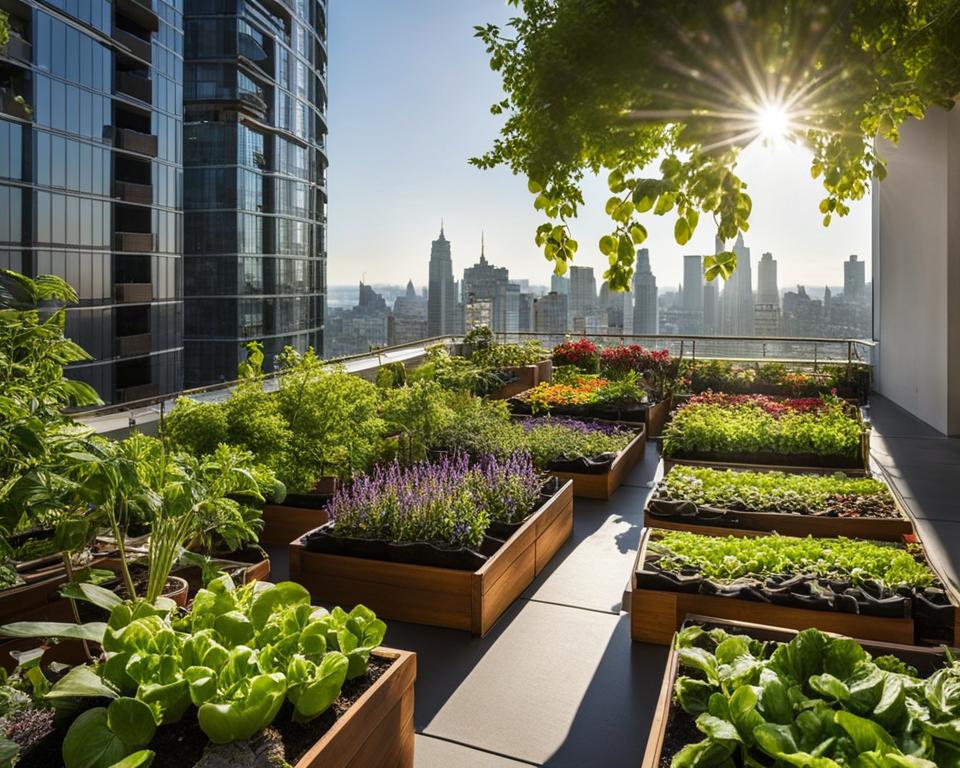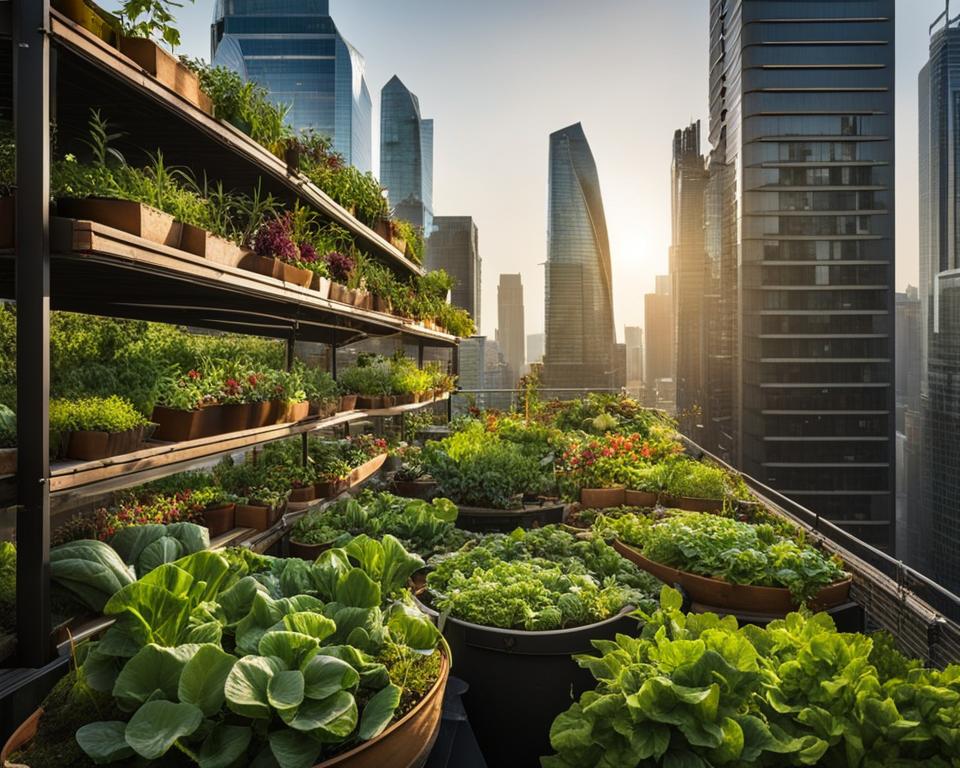Are you ready to embark on a green adventure right in the heart of the city? Join me as we explore the world of urban rooftop gardening and discover the incredible potential it holds. With its ability to transform concrete jungles into lush green oases, urban rooftop gardening has become a popular trend gaining momentum across the United States.
The People’s Potato Garden at Loyola Campus
Located on Concordia University’s Loyola campus, the People’s Potato garden is a thriving urban garden that serves as a beacon of sustainability and community engagement. Led by Eseosa Idemudia, this garden is more than just a place to grow food – it’s a movement that aims to address issues such as food insecurity and empower individuals to take control of their own food sources.
The People’s Potato garden is not only a provider of free vegan meals to students and the community, but it also serves as an educational space for volunteers to learn about sustainable farming practices. Through hands-on experience, volunteers gain valuable knowledge about organic gardening, composting, and the importance of locally grown food.
One of the unique aspects of the People’s Potato garden is its intergenerational collaboration. Students and older adults work side by side, sharing their knowledge and experiences, and creating a sense of connectedness within the community. This collaboration not only benefits the garden itself but also fosters a sense of belonging and strengthens social bonds among participants.
Table: Impact of the People’s Potato Garden
| Category | Impact |
|---|---|
| Food Security | Provides free vegan meals to students and the community |
| Sustainability | Creates an educational space for learning about sustainable farming practices |
| Intergenerational Collaboration | Fosters collaboration between students and older adults, promoting a sense of connectedness |
The People’s Potato garden at Loyola campus serves as a shining example of how urban gardens can address pressing social issues while fostering a sense of community and connection with nature. Through their commitment to sustainability and empowerment, this garden is making a positive impact on the lives of individuals and the environment as a whole.
The Mind·heart·mouth Collective Garden
The mind·heart·mouth collective garden, founded by Andrea Tremblay, is an urban garden located on Concordia University’s Loyola campus. This unique and immersive garden experience is designed to foster a deep sense of connectedness with nature while providing sustainable food to the community.
Creating an Immersive Garden Experience
The mind·heart·mouth collective garden aims to create an immersive experience for volunteers. It encourages individuals to interact with plants, appreciate the beauty and harmony of nature, and find moments of peace and reflection in the midst of a bustling urban environment.
“Being in the mind·heart·mouth garden feels like stepping into a different world. It’s a place where I can escape the noise of the city and reconnect with nature. It’s a space that inspires me to slow down, appreciate the simple beauty of plants, and reflect on my own connection to the earth.” – Volunteer
Promoting Sustainable Food Production
One of the key goals of the mind·heart·mouth collective garden is to provide sustainable food to the community. By growing a wide variety of fruits, vegetables, and herbs, the garden not only offers fresh and nutritious produce but also promotes the importance of local food production and reducing reliance on industrialized agriculture.
Creating a Space for Reflection and Meditation
Beyond providing sustenance, the mind·heart·mouth collective garden serves as a peaceful sanctuary for reflection and meditation. It offers a refuge from the busy urban environment, allowing individuals to find solace, clarity, and a renewed sense of purpose.

The CultivAction Urban Garden
Urban agriculture plays a crucial role in addressing food security and promoting sustainability in cities. The CultivAction urban garden, located on Concordia University’s Loyola campus, is a remarkable initiative that aims to tackle these pressing issues. As a solidarity co-operative of urban farmers, CultivAction offers workshops and courses on urban gardening, empowering individuals to grow their own food and contribute to local food production. Through their urban farm, CultivAction not only provides fresh produce to the community but also educates and inspires people to make a positive impact on their surrounding environment.
One of the key highlights of the CultivAction urban garden is its commitment to ecological sustainability. By utilizing innovative techniques such as vertical gardening and container farming, the co-operative maximizes limited space and ensures efficient use of resources. This approach not only increases food production but also minimizes waste and reduces the ecological footprint associated with traditional agriculture. CultivAction serves as a model for urban agriculture, demonstrating how urban spaces can be transformed into thriving ecosystems that support local food systems and enhance food security.
The Impact of CultivAction Urban Garden
The CultivAction urban garden has had a significant impact on the Loyola campus and the surrounding community. By supplying fresh produce to local markets and restaurants, the co-operative stimulates the local economy and promotes the importance of supporting local producers. The garden also serves as a gathering space, fostering community engagement and social interaction. Volunteers and visitors can learn about sustainable farming practices, exchange knowledge, and build lasting connections. Moreover, the CultivAction urban garden inspires individuals to reconnect with nature, appreciate the value of food, and take active steps towards food security in their own lives.
| Benefits of the CultivAction Urban Garden | Impact |
|---|---|
| Promotes local food production | Reduces dependence on imported produce and supports the local economy |
| Enhances ecological sustainability | Minimizes carbon footprint, reduces waste, and conserves natural resources |
| Fosters community engagement | Provides a space for collaboration, knowledge sharing, and social interaction |
| Empowers individuals | Teaches gardening skills, promotes self-sufficiency, and enhances food security |
“The CultivAction urban garden is a testament to the power of collective action and the potential for urban agriculture to transform our cities. It not only provides fresh, locally grown produce to the community but also serves as an educational hub and a catalyst for social change. By cultivating a deeper connection with the food we consume and the environment we inhabit, we can create a more sustainable and resilient future.”

The CultivAction urban garden stands as a shining example of how urban agriculture can address food security challenges and promote sustainable practices in an urban setting. Through their innovative and inclusive approach, this co-operative has fostered a sense of community, empowered individuals, and inspired others to take part in shaping a more resilient and food-secure future. As we continue to face the impacts of climate change and a growing global population, initiatives like CultivAction are essential for building a more sustainable and equitable world.
The Rise of Urban Gardens
Urban gardens have been a significant part of immigrant communities and urban activist movements for decades. They have served as sources of fresh food, places of community engagement, and symbols of resilience. However, in recent years, the rise of urban gardens can be attributed to a growing awareness of the need for food security and self-sufficiency in the face of the climate crisis.
Urban gardening allows individuals and communities to take control of their food production, reduce their ecological footprint, and strengthen their connection to the land. By utilizing vacant lots, rooftops, and even vertical spaces, urban gardens bring greenery to concrete jungles and contribute to biodiversity conservation. They provide an opportunity for people to grow fresh and nutritious food in urban environments where access to green spaces and quality produce may be limited.
Furthermore, urban gardens foster a sense of community and social cohesion. They become spaces where people can gather, learn from one another, and share their knowledge and experiences. By working together in urban gardens, individuals build relationships and form supportive networks, enhancing both social ties and community resilience.
In an era of increasing urbanization and environmental challenges, urban gardens offer a practical and empowering solution. They not only address the pressing issues of food security and self-sufficiency but also provide a path towards a more sustainable and resilient future for our cities and communities.
| Benefits of Urban Gardens | Keywords |
|---|---|
| Enhances food security | food security |
| Reduces ecological footprint | ecological sustainability |
| Promotes community engagement | community engagement |
| Increases biodiversity | biodiversity conservation |
| Provides access to fresh and nutritious food | fresh produce |
| Strengthens social ties and community resilience | social cohesion |
The Benefits of Urban Rooftop Gardening
Urban rooftop gardening offers numerous benefits that contribute to a more sustainable and vibrant urban environment. By utilizing the often-unused rooftop spaces in cities, we can transform them into thriving gardens that provide a multitude of advantages.
Enhancing Environmental Sustainability
One of the key benefits of urban rooftop gardening is its positive impact on the environment. Rooftop gardens help mitigate the urban heat island effect by absorbing and reducing heat, thereby cooling the surrounding area. They also act as natural insulation, reducing energy consumption and lowering greenhouse gas emissions.
Rooftop gardens promote biodiversity by providing habitats for birds, insects, and other wildlife species in urban areas. The diverse range of plants and greenery in these gardens helps improve air quality by capturing pollutants and releasing oxygen. These gardens also act as natural water filters, reducing stormwater runoff and the burden on city drainage systems.
Improving Food Security and Local Food Production
Rooftop gardens offer opportunities for local food production, contributing to food security in urban areas. By growing fresh produce on rooftops, communities can have access to nutritious, locally sourced food. This reduces reliance on imported produce and decreases the carbon footprint associated with transportation and packaging.
Furthermore, urban rooftop gardening promotes self-sufficiency and resilience in the face of potential food shortages or disruptions. Individuals and communities can grow their own fruits, vegetables, and herbs, ensuring a constant supply of fresh and healthy food.
Creating Community Spaces and Aesthetic Appeal
Rooftop gardens serve as communal spaces where people can come together, connect with nature, and foster a sense of community. These gardens provide opportunities for social interaction, learning, and shared experiences. They can be used for educational workshops, social gatherings, or simply as tranquil retreats within the urban landscape.
Additionally, rooftop gardens enhance the aesthetic appeal of cities by adding green spaces and natural beauty to the concrete jungle. These gardens create a visually appealing environment that improves the overall quality of life for residents, workers, and visitors.

Maximize Space with Vertical Gardening
When working with limited space, vertical gardening techniques can help maximize your rooftop garden’s potential. Utilize trellises, hanging baskets, and vertical planters to create a lush green wall. This not only increases the number of plants you can grow but also adds visual interest and dimension to your rooftop garden.
Starting an urban rooftop garden requires careful planning and consideration. By auditing your rooftop, creating adequate drainage, choosing the right plants, and maximizing space with vertical gardening, you can create a thriving garden oasis right above the city skyline.
Urban Rooftop Garden Design
Designing an urban rooftop garden is an exciting opportunity to create a unique and beautiful space that combines nature and urban living. Whether you have a small rooftop terrace or a larger area to work with, there are endless possibilities for creating a functional and aesthetically pleasing garden. By considering the layout, materials, and plant selections, you can transform your rooftop into a vibrant oasis.
Layout and Pathways
When designing your rooftop garden, think about how you want to utilize the space. Consider creating designated areas for relaxation, dining, and gardening. Pathways can guide visitors through the garden and provide a sense of flow. You can use materials like stone, wood, or gravel to define the pathways and add visual interest.
Seating Areas
Incorporating seating areas into your rooftop garden allows you to fully enjoy the space. Consider installing benches, outdoor sofas, or even hammocks where you can relax and soak in the beautiful views. Placing seating areas strategically can also create cozy nooks and maximize the use of space.
Plant Arrangements
The choice of plants in your rooftop garden can greatly impact the overall design and atmosphere. Consider using a combination of different plant types, including flowering plants, foliage plants, and even small trees or shrubs. Vertical gardening techniques such as trellises or hanging baskets can add depth and make the most of limited space.
| Plant Type | Best for Rooftop Gardens |
|---|---|
| Drought-tolerant plants | Require less water and can thrive in rooftop environments. |
| Succulents | Add unique textures and require minimal maintenance. |
| Native grasses | Bring a natural look and require low water usage. |
| Vegetables and herbs | Provide fresh produce and can be easily grown in containers. |
| Small fruit trees | Add height and provide seasonal fruits in limited spaces. |
Remember to choose plants that are suitable for your specific rooftop environment, considering factors such as sunlight exposure and wind conditions.
By carefully considering the layout, seating areas, and plant arrangements, you can create a stunning rooftop garden that not only enhances your living space but also provides a sanctuary within the urban landscape.
Urban Rooftop Garden Plants
Creating an urban rooftop garden offers a unique opportunity to cultivate a wide variety of plants that can thrive in the rooftop environment. When selecting the right plants for your rooftop garden, it’s important to consider factors such as sunlight exposure, wind conditions, and space limitations. By choosing the right combination of plants, you can create a lush and vibrant green space that not only beautifies your rooftop but also provides a sustainable source of fresh herbs, vegetables, and even small fruit trees.
Drought-tolerant plants are particularly well-suited for rooftop gardens, as they can withstand the heat and limited water availability that often comes with rooftop environments. Succulents like sedum, agave, and aeonium are excellent choices as they store water in their leaves, making them highly adaptable to arid conditions. Native grasses, such as feather reed grass and little bluestem, are also well-suited for rooftop gardens, as they require minimal maintenance and can provide a beautiful and textured landscape.
In addition to drought-tolerant plants, consider incorporating a selection of vegetables and herbs into your rooftop garden. Many vegetables, such as tomatoes, peppers, and leafy greens, can be grown in containers or raised beds, making them ideal for rooftop gardens. Fresh herbs like basil, rosemary, and thyme not only add flavor to your cooking but also provide aromatic scents that can enhance your rooftop garden experience. If space allows, consider adding small fruit trees like dwarf apple or citrus trees, which can be grown in containers and provide a delightful source of fresh, homegrown fruit.
Table: Recommended Plants for Urban Rooftop Gardens
| Plant Type | Recommended Plants |
|---|---|
| Drought-Tolerant Succulents | Sedum, Agave, Aeonium |
| Drought-Tolerant Grasses | Feather Reed Grass, Little Bluestem |
| Vegetables | Tomatoes, Peppers, Leafy Greens |
| Herbs | Basil, Rosemary, Thyme |
| Small Fruit Trees | Dwarf Apple, Dwarf Citrus |
When designing your urban rooftop garden, don’t forget to incorporate vertical gardening techniques to maximize space and allow for a greater variety of plants. Trellises and arbors can be used to support climbing plants like cucumbers, beans, and grapes, adding visual interest and creating a lush vertical garden. Hanging baskets can also be utilized to grow trailing plants such as strawberries or trailing vines, making use of otherwise unused vertical space.
With careful consideration of sunlight, wind, and space limitations, you can create a thriving urban rooftop garden that not only adds beauty to your surroundings but also provides a sustainable source of fresh produce. So, grab your gardening gloves and get ready to experience the joy and abundance of an urban rooftop garden.
The Joy of Urban Rooftop Gardening
Urban rooftop gardening is a fulfilling and rewarding endeavor that brings joy and a sense of purpose to those who partake in it. This unique form of gardening allows individuals to reconnect with nature, grow their own food, and contribute to a more sustainable future. Whether it’s the thrill of harvesting fresh produce, the satisfaction of creating a beautiful green space, or the sense of community that comes from sharing the garden with others, urban rooftop gardening offers a multitude of joys.
One of the greatest joys of urban rooftop gardening is the ability to reap the fruits of your labor. There is nothing quite like the taste of freshly picked vegetables or herbs that you have grown with your own hands. The experience of nurturing a seedling, watching it grow, and finally enjoying the bounty it produces is incredibly gratifying. Urban rooftop gardens provide the opportunity to savor the flavors of nature and take pride in the food you have cultivated.
Creating a lush green oasis in the heart of the city is another joy of urban rooftop gardening. Rooftop gardens not only enhance the aesthetic appeal of urban areas but also provide much-needed green space in concrete jungles. The sight of vibrant plants, colorful flowers, and buzzing pollinators can bring a sense of tranquility and peace amidst the hustle and bustle of city life. Moreover, rooftop gardens offer a sanctuary for birds and insects, contributing to the overall biodiversity and ecological balance of the urban environment.
Lastly, urban rooftop gardening fosters a sense of community and connection. Sharing the joys and challenges of gardening with others creates bonds and strengthens relationships. Rooftop gardens can serve as gathering spaces for neighbors, friends, and family members to come together, share knowledge, and learn from one another. The collaborative and inclusive nature of urban rooftop gardening nurtures a sense of belonging and solidarity, creating a supportive community that celebrates the joys of gardening together.
The Future of Urban Rooftop Gardening
Urban rooftop gardening is not just a passing trend; it represents the future of sustainable urban landscapes. As cities continue to grow and green spaces become more limited, rooftops offer a valuable opportunity to create vibrant gardens that provide numerous benefits to individuals and communities alike. The potential of urban rooftop gardening is immense, and its positive impact on food security, ecological sustainability, and quality of life in cities cannot be underestimated.
Advancements in technology and urban agriculture practices are paving the way for the further development and accessibility of urban rooftop gardens. Architects and designers are incorporating rooftop gardens into building plans, creating integrated and functional spaces that seamlessly blend nature with urban infrastructure. This integration not only enhances the aesthetic appeal of buildings but also contributes to the overall well-being of urban dwellers.
With the rise in demand for locally grown food and the need to address climate change, urban rooftop gardening is poised to play a vital role in our future. These gardens allow individuals and communities to produce their own fresh food, reducing the need for long-distance transportation and the associated carbon emissions. They also promote self-sufficiency and food security, empowering people to take control of their own food production.
Rooftop gardens offer more than just food production; they also provide a wide range of environmental benefits. By creating green spaces in otherwise concrete-dominated urban areas, rooftop gardens help mitigate the urban heat island effect, reduce energy consumption, and improve air quality. They serve as habitats for birds, insects, and other wildlife, promoting biodiversity and creating a balanced ecosystem within the city.
In Conclusion
Urban rooftop gardening is not just a niche hobby; it is a sustainable solution to many challenges faced by urban communities. By harnessing the potential of rooftops, we can create thriving gardens that provide fresh food, improve the environment, and enhance the quality of life for city dwellers. Whether you have a small rooftop or a large commercial building, there are endless possibilities for transforming these spaces into green oases.
So, let’s embrace the future of urban rooftop gardening and unlock the magic of nature right above our heads!
Conclusion
Urban rooftop gardening is a magical way to transform city spaces into vibrant and sustainable havens. By harnessing the potential of rooftop gardens, we can embrace the wonders of nature right under the sky. From providing fresh produce to fostering community engagement, rooftop gardens offer a multitude of benefits for individuals and communities alike.
With their ability to efficiently utilize limited space, rooftop gardens are a perfect solution for densely populated urban areas. They can help mitigate the urban heat island effect, reduce energy consumption, and improve air quality. Not only do they promote local food production and biodiversity, but they also serve as communal spaces for social interaction and community building.
Starting an urban rooftop garden may require careful planning, but the rewards are well worth it. By assessing the structural integrity of the rooftop, ensuring proper drainage, and selecting suitable plants, we can create thriving green spaces that enhance the aesthetic appeal of our cities. Whether it’s designing beautiful pathways, incorporating trellises and water features, or experimenting with vertical gardening techniques, the possibilities for creating an enchanting rooftop garden are endless.
The future of urban rooftop gardening looks promising. As urbanization continues to rise and the demand for locally grown food increases, these gardens will play a vital role in shaping the urban landscape. With advancements in technology and urban agriculture practices, rooftop gardens will become even more accessible and integrated into building designs. Together, let’s unlock the potential of urban rooftop gardening and create sustainable and vibrant environments for ourselves and future generations.
FAQ
What is urban rooftop gardening?
Urban rooftop gardening is the practice of growing plants, vegetables, and herbs on rooftops in urban areas. It allows individuals to utilize limited space and create green oases in the city.
What are the benefits of urban rooftop gardening?
Urban rooftop gardening offers numerous benefits, including efficient use of space, mitigation of the urban heat island effect, improved air quality, opportunities for local food production, and enhanced aesthetic appeal of urban areas.
How do I start an urban rooftop garden?
To start an urban rooftop garden, you should assess the structural integrity of the rooftop, ensure proper drainage, select suitable plants, and utilize containers, raised beds, and vertical gardening techniques.
What plants are suitable for urban rooftop gardens?
Suitable plants for urban rooftop gardens include drought-tolerant plants like succulents and native grasses, as well as vegetables, herbs, and small fruit trees that can be grown in containers or raised beds.
What is the future of urban rooftop gardening?
As the demand for locally grown food and awareness of the need for food security and self-sufficiency increase, urban rooftop gardening is expected to become even more prevalent. Integrating rooftop gardens into building designs and advancements in technology will further enhance its viability and accessibility.

